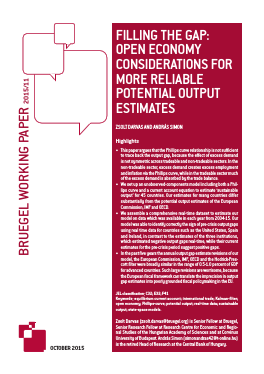Blog Post
Mind the gap! And the way structural budget balances are calculated*
The so-called structural balance of the general government aims to measure the ‘underlying’ position of the budget by excluding the impact of the economic cycle and one-off measures, like bank recapitalisation costs. It has a crucial role in designing fiscal consolidation strategies in the EU (see the Annex at the end).
The so-called structural balance of the general government aims to measure the ‘underlying’ position of the budget by excluding the impact of the economic cycle and one-off measures, like bank recapitalisation costs. It has a crucial role in designing fiscal consolidation strategies in the EU (see the Annex at the end).
Late September, a report in WSJ suggested that the methodology for calculating the structural balance may be revised to make it more reasonable, which would have also eased austerity in hard-hit European countries. The proposal has been rejected a few days later, but the debate on the methodology and its impact on actual fiscal policy will certainly come back soon. Let me try to explain and illustrate the main issues in a simple way and formulate a more general critique of the calculation of the output gap (the difference between actual and potential output), which is the main input to structural balance calculations. Also, I propose an alternative.
The structural balance is an intuitive concept. It is the budget balance cleaned from temporary effects: the impact of the economic cycle and one-off budgetary measures. For example, in a deep recession tax revenues are smaller and unemployment benefit expenditures are larger, but once the economy returns to the potential level of output, both tax revenues and unemployment benefit expenditures return to normal. Also, in a given year, one-off budgetary measures, such as bail-out of banks, can make the actual deficit large, or a temporary tax can make the budget look better.
However simple is the intuition, the structural balance is not observable and its estimation implicates difficulties, uncertainties and controversies, as it requires the quantification of:
(a) potential output, i.e. the output that could be produced if all resources were employed at their long-term sustainable levels. The gap between actual and potential is the output gap;
(b) the impact of the output gap on the budget balance; and
(c) one-off budgetary measures and their impact on the budget balance.
Of these, measuring potential output is the most controversial, though the other two tasks are not easy either. The potential output methodology used in the EU is based on a production function, which uses three main inputs: capital, labour and total factor productivity. For calculating potential output, the following main assumptions are made:
- Capital: the actual capital stock (typically measured as accumulated investments less amortisation) is used;
- Labour: after identifying labour supply, a measure of ‘equilibrium’ unemployment rate, the so-called NAWRU (non-accelerating wage rate of unemployment), is used to estimate the sustainable level of employment. NAWRU is estimated with a statistical technique;
- Total factor productivity: actual data on productivity is not directly observable; instead, it is measured as a residual after taking into account the contributions of capital and labour to actual output, which typically leads to a volatile time-series for productivity. For calculating potential output, it is assumed that productivity changes along a smooth path and a statistical method (initially the Hodrick-Prescott filter, while since 2010 an unobserved components model) is used to adjust actual data to this smoothness concept.
All three assumptions are problematic.
Capital
Before the crisis, significant physical capacities were built in sectors that proved to be unsustainable, like the construction sector. Moving physical capital from one sector to another is not always easy, e.g. a crane cannot be used to make smartphones. Therefore, some of the capacities built before the crisis should not be taken into account when estimating production factors at their long-term sustainable levels. The good news is that Output Gap Working Group of the EU is working on the revision of the methodology to better consider the sustainable component of capital (see page 7 and section 4 of the methodological paper referred above).
Labour
The issue that receives the most attention nowadays is the methodology for estimating NAWRU. In the case of Spain, the forecast NAWRU for 2013 is as high as 23.7%, suggesting that actual employment is close to potential (because the unemployment rate forecast is 27% – see Figure 1). The forecasts for 2014 suggest that the two indicators will be even closer to each other: the NAWRU forecast is 25.9%, while the unemployment rate forecast is 26.4%. For Ireland the actual unemployment rate is expected to fall below the NAWRU estimate in 2014, suggesting that there will be ‘excess employment’.
In other words, almost all presently unemployed people are regarded useless from the perspective of the production potential of the economy. This is strange indeed, even though it may be difficult to employ all former construction workers in other sectors in the coming years.
If the actual unemployment rate is close to the NAWRU, actual employment is close to potential and thereby actual output is also close to potential, i.e. the output gap is small. If the output gap is small, the structural budget balance is close to the actual budget balance, and therefore a large actual budget deficit implies a similarly large structural deficit. In turn, the estimated large structural deficit requires large fiscal consolidation needs, according to the EU fiscal rules.
But a NAWRU well below the actual unemployment rate would suggest that there is ample unused labour in the economy and therefore the potential output is much higher than actual output, i.e. the negative output gap is large. In that case, the structural balance is much better than the actual budget balance, implying lower fiscal consolidation needs.
Therefore, the results of NAWRU estimations have implications for fiscal adjustment strategies.
A major problem with the NAWRU methodology is that the view on the share of ‘useless’ unemployed people can be revised along with the revision of the unemployment rate forecast. The case of Latvia is illuminating in this regard (Figure 1): let me highlight two cases. First, in April 2007, the NAWRU in 2007 was seen at 6.3% and was forecast to fall to 4.9% in 2008 and even further later. But now (based on the May 2013 forecast of the Commission) the 2007 NAWRU is estimated to be 11.4%, while the 2008 NAWRU estimate is 11.8%. Second, in April 2010, the huge increase in the actual unemployment rate led the methodology to conclude that the NAWRU has increased to a high level and was forecast to increase even further, to 19.4% by 2011. But later, when the unemployment rate declined (which, by the way, was partly the result of emigration of unemployed people), the NAWRU estimates for the past and the forecasts for the future were revised downward significantly. Currently, the estimate for the 2011 NAWRU is 13.8%.
Figure 1: The NAWRU estimates and forecast at different dates and the actual unemployment rate, 1995-2014
Source: Various vintages of the Spring Economic forecasts of the European Commission. Note: the 2013-14 values of the unemployment rate are from the Commission forecast published in May 2013. For NAWRU, we report the estimates made in the springs of 2007, 2010 and 2013. The last two data points of each vintage of NAWRU estimates are forecast made at the time.
Productivity
As said above, it is assumed in the EU methodology that TFP develops along a smooth path. When calculating the smoothed time series of TFP, forecasts are also taken in to account: among others, forecasts for GDP, labour (including NAWRU) and capital (investment) matter for the TFP forecast. A major problem is the instability of the estimates at toward the end of the sample period, which is also recognised in the official documentation of the potential output methodology. When e.g. a forecast turns to be too optimistic and thereby actual TFP turns to be smaller than forecasted, the smoothness assumption will imply that TFP for earlier years will be revised downward as well. This in turn will revise downward potential output estimates. This problem was a major reason for replacing the Hodrick-Prescott filter with an unobserved components model in 2010, yet major revisions were made in the past and it needs to be seen if the new methodology will prove to be more robust to the arrival of new data.
Now let’s see how potential output estimates and forecasts have changed (Figure 2).
Figure 2: Potential output estimates and forecasts at different dates and the actual GDP, 2000-2014
Source: Various vintages of the Spring Economic forecasts of the European Commission. Note: the 2013-14 values of actual GDP are from the Commission forecast published in May 2013. For potential GDP, we used the output gap estimates made in the springs of 2007, 2010 and 2013 and calculated potential output using the most recent data for actual GDP and the output gap estimates. Thereby, the revisions of actual GDP data do not impact the potential output estimates we show, but only the revisions of the output gap estimates. The last two data points of each vintage of potential output estimates are forecast made at the time.
Figure 2 suggests that there were major revisions in potential output estimates. For example, the 2007 spring estimates reported that the Irish and Spanish GDP were below potential in 2005-2007 (and were forecast to stay below potential in 2008 too). On the contrary, the 2013 spring estimate indicates that in 2007 Irish output was 4% above potential, while in Spain the output gap was 2%. Even larger revisions were made for Latvia: in spring 2007, the 2007 output gap was estimated to be around 1%, while during 2009-2012 the 2007 output gap estimate was around 14-15%. The 2013 spring forecast lowered the 2007 output gap estimate to 11%: still, more than 11-times the real-time estimate made in 2007.
To sum up, the EU methodology for estimating potential output has serious drawbacks – and since this methodology is used to estimate structural budget balances, the uncertainty in estimating potential output can have implications for the fiscal adjustment requirements along the SGP and Fiscal Compact. This does not sound good.
I would like to offer an alternative. One reason for the inability of the EU’s methodology to correctly identify the economic cycle in real time is that it focuses only on the relationship between the output gap and labour market tensions via the NAWRU. While in a large and closed economy such a relationship may describe the impact of the output gap reasonably well, it is certainly insufficient for small open economies. In latter economies, much of the excess demand (i.e. positive output gap) is absorbed by the trade balance and this has indeed happened in Greece, Ireland, Latvia and Spain: before the crisis, the trade balance in these countries deteriorated rapidly. With András Simon, my former colleague at the Hungarian central bank, we are currently working on a model of potential output that incorporates this effect. Watch out for our paper in the coming months.
* The title of this post is a tribute to late Gábor Vadas, my great former colleague and co-author at the central bank of Hungary, who wrote several papers on related topics, including a 2005 paper co-authored with Gábor P. Kiss titled “Mind the Gap – International Comparison of Cyclical Adjustment of the Budget”
Annex: The main roles of the structural budget balance in the EU fiscal governance framework:
- The Stability and Growth Pact (SGP) defines the fiscal consolidation effort in terms of the structural balance that a country under the Excessive Deficit Procedure (EDP) has to take: at least 0.5% of GDP fiscal adjustment per year is required, and even more for countries with debt to GDP ratios over 60%.
- The Fiscal Compact (formally, Treaty on Stability, Coordination and Governance in the Economic and Monetary Union – TSCG) stipulates that the structural budget deficit cannot be larger than 0.5% of GDP (unless the debt to GDP ratio is significantly lower than 60%, in which case the structural deficit can reach one percent of GDP).
Republishing and referencing
Bruegel considers itself a public good and takes no institutional standpoint. Anyone is free to republish and/or quote this post without prior consent. Please provide a full reference, clearly stating Bruegel and the relevant author as the source, and include a prominent hyperlink to the original post.





